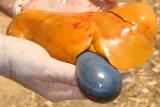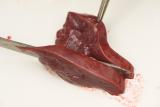Calling a vet to investigate disease protects marketsThe WA Livestock Disease Outlook provides information about recent livestock disease cases in Western Australia and diseases likely to occur in the next month. Calling a vet to investigate diseases when they occur provides surveillance evidence to our markets that we are free of reportable and trade-sensitive diseases. |
Recent livestock disease cases in WA
Respiratory disease and deaths in calves in the far north
- In a group of 150 calves, 7 were found dead and 15 affected with severe breathing difficulty and weakness.
- The calves had been in yards for two weeks due to cyclonic weather. The calves developed disease signs a few days after being returned to the paddock.
- On postmortem, 3 out of 4 calves had liver and lung abscesses.
- Laboratory testing showed pneumonia and inflammation of the liver and the pericardium around the heart. The pneumonia was likely due to the bacteria Pasteurella.
- The risk of bacterial pneumonia in calves may be increased during periods of close confinement and stress such as yarding as the bacteria is easily spread through aerosol and close contact. The risk can be reduced by addressing stress factors where possible and ensuring good overall immunity.
- The exotic disease, haemorrhagic septicaemia (caused by certain types of Pasteurella multocida) and the reportable disease, anthrax, were ruled out by the laboratory testing, helping to support WA’s proof of freedom from these diseases and ensuring we retain access to export markets.
Lupinosis and nutritional myopathy caused deaths in Wheatbelt sheep
- More than 200 Merino wethers died on one property in January following summer rainfall.
- Sheep were grazing lupin stubble and the deaths were attributed to lupinosis. The producer immediately put the sheep on oat stubble and hay to stop losses.
- A month later, deaths in the flock began again and further investigation was undertaken.
- Two sheep were submitted for laboratory investigation: one with weakness, fatigue and pale mucous membranes; and one 4-year-old sheep with weakness and head pressing that later died.
- Mild liver disease in the first sheep was consistent with the previous diagnosis of lupinosis but changes to the muscles and extremely low vitamin E indicated the sheep was also affected by nutritional myopathy. Nutritional myopathy is usually associated with vitamin E or selenium deficiency but has also been associated with lupinosis.
- The second sheep was diagnosed with chronic lupinosis but given its age and the presence of neurological signs, the brain was submitted for laboratory testing for transmissible spongiform encephalopathies (TSE). The test results were negative, which helped to support Australia’s proof of freedom from scrapie and to maintain our access to export markets.
- A vitamin E drench would address the vitamin E deficiency in this case, and limiting unnecessary movement of the sheep would reduce the potential for further muscle damage and deaths in sheep with nutritional myopathy.


